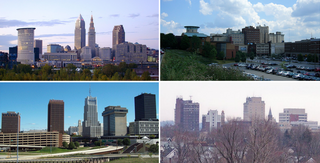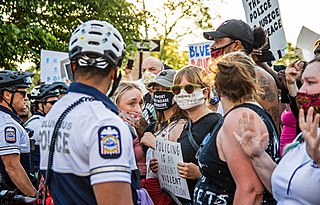
Cuyahoga County is a large urban county located in the northeastern part of the U.S. state of Ohio. It is situated on the southern shore of Lake Erie, across the U.S.-Canada maritime border. As of the 2020 census, its population was 1,264,817, making it the second-most-populous county in the state.

In the United States, trolley parks, which started in the 19th century, were picnic and recreation areas along or at the ends of streetcar lines in most of the larger cities. These were precursors to amusement parks. Trolley parks were often created by the streetcar companies to give people a reason to use their services on weekends.

The region Northeast Ohio, in the US state of Ohio, in its most expansive usage contains six metropolitan statistical areas: Cleveland–Elyria, Akron, Canton–Massillon, Youngstown–Warren, Mansfield, and Weirton–Steubenville along with eight micropolitan statistical areas. Most of the region is considered either part of the Cleveland–Akron–Canton, OH Combined Statistical Area and media market or the Youngstown–Warren, OH-PA Combined Statistical Area and media market. In total the region is home to 4,502,460 residents. It is also a part of the Great Lakes megalopolis, containing over 54 million people. Northeast Ohio also includes most of the area known historically as the Connecticut Western Reserve. In 2011, the Intelligent Community Forum ranked Northeast Ohio as a global Smart 21 Communities list. It has the highest concentration of Hungarian Americans in the United States.
Cuyahoga County Public Library (CCPL) has 27 branches that serve 47 communities in Cuyahoga County, Ohio. It was ranked the number one public library in the United States among libraries serving populations of more than 500,000 by the Hennen's American Public Library Ratings 2010. In 2009, more than 19 million items were borrowed by its 528,449 cardholders, and 7.6 million visits were made to branches.
These congregations are affiliated with one of the five associations comprising the Heartland Conference of the United Church of Christ. They are listed in order of association.
Ohio Mayor's Courts are state courts in Ohio created by some municipalities. The Mayor's Courts hear traffic cases, violations of city ordinances and other misdemeanors. The presiding officer is a magistrate appointed by the mayor, or even being the mayor, and paid by the city or village.
The electoral history of each district in the Ohio House of Representatives can be traced from 1966 to the present.
This is a list of high school athletic conferences in the Northeast Region of Ohio, as defined by the OHSAA. Because the names of localities and their corresponding high schools do not always match and because there is often a possibility of ambiguity with respect to either the name of a locality or the name of a high school, the following table gives both in every case, with the locality name first, in plain type, and the high school name second in boldface type. The school's team nickname is given last.

Beginning on May 28, 2020, a number of cities in Ohio saw protests against the murder of George Floyd. Major cities such as Columbus, Cleveland, Cincinnati and Dayton had large protests, and numerous smaller cities and towns saw demonstrations as well. As a result of rioting and looting, a number of cities such as Cleveland, Columbus, Dayton, Cincinnati and Springfield imposed curfews of varying times.




